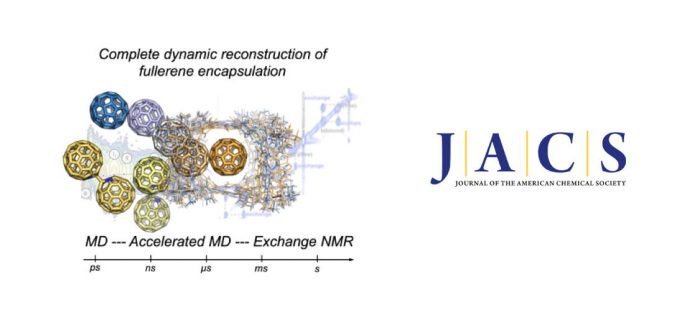The dynamic adaptability of a supramolecular tetragonal prismatic nanocapsule in the selective separation of fullerenes and endohedral metallofullerenes (EMFs) remained unexplored. Therefore, the essential molecular details of the fullerene recognition and binding process into the coordination capsule and the origins of fullerene selectivity remained elusive. In this work, the key steps of fullerene recognition and binding processes have been deciphered by designing a protocol which combines 1H-1H exchange spectroscopy (2D-EXSY) NMR experiments, long time-scale Molecular Dynamics (MD) and accelerated Molecular Dynamics (aMD) simulations, which are combined to completely reconstruct the spontaneous binding and unbinding pathways from nanosecond to second time-range.
On one hand, binding (k’on) and unbinding (koff) rate constants were extracted from 1H-1H exchange spectroscopy (EXSY) NMR experiments for both C60 and C70. On the other hand, MD and aMD simulations allowed monitoring the molecular basis of the encapsulation and guest competition processes at a very early stage under non-equilibrium conditions. The receptor capsule displays dynamical adaptability features similar to those observed in the process of biomolecular recognition in proteins. In addition, the encapsulation of bis-aza[60]fullerene (C59N)2 within a supramolecular coordination capsule has been studied for the first time, showcasing the pros and cons of the dumbbell-shaped guest in the dynamics of the encapsulation process and in the stability of the final bound adduct. The powerful combination of NMR, MD, and aMD methodologies allows to obtain a precise picture of the subtle events directing the encapsulation, and is thus a predictive tool for understanding host-guest encapsulation and interactions in numerous supramolecular systems.
This experimental-computational work involved the synergistic collaboration between research groups from IQCC: Cristina García-Simón, Cédric Colomban, Míriam Pujals, Ernest Ubasart, Carles Fuertes-Espinosa, Miquel Costas, and Xavi Ribas (experimental) and Ferran Feixas (computational). The project also involved the participation of Ana Gimeno and Jesús Jiménez-Barbero (CIC bioGUNE) and Karam Asad and Nikos Chronakis (University of Cyprus). Part of the MD simulations were carried out by Yarkin Aybars Çetin (MACMoM master student) during the master thesis.
C. García-Simón, C. Colomban, Y. Aybars Çetin, A. Gimeno, M. Pujals, E. Ubasart, C. Fuertes-Espinosa, K. Asad, N. Chronakis, M. Costas, J. Jiménez-Barbero, F. Feixas, and X. Ribas
“Complete dynamic reconstruction of C60, C70 and (C59N)2 encapsulation into an adaptable supramolecular nanocapsule”
J. Am. Chem. Soc. 2020, ASAP
DOI: 10.1021/jacs.0c07591
Girona, August 26, 2020
For more information: gestor.iqcc@gmail.com

